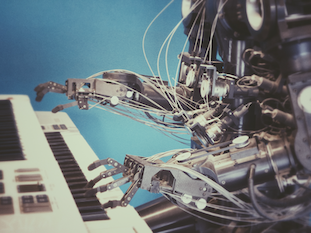Main menu
HELP
|
Call for Papers (Tract conference and/or Palimpsestes no. 38)
LITERARY TRANSLATION AND AI: ASSESSING CHANGES IN TRANSLATION THEORY, PRACTICE AND CREATIVITY
20-21 October 2022, Sorbonne Nouvelle
Thursday 20 and Friday 21 October 2022 - Sorbonne Nouvelle
Maison de la recherche, 4 rue des Irlandais, 75005 Paris
Athéna Room
Deadline for submissions: June 6, 2022 Notification of acceptance: July 1, 2022
Keynote lecture Antonio Toral, Computational Linguistics Group, Center for Language and Cognition, Université de Groningen
Practice-based workshop How to Train your Own Neural Machine Translation Program, with Damien Hansen, translator and PhD candidate Universités de Liège et Grenoble-Alpes
Introduction In early 2020, we discussed the possibility of organizing a TRACT seminar series on machine translation (MT) of literary texts. Since then, this topic has been the subject of an ever-increasing number of conferences, articles and monographs. It is probably the spectacular "progress" of MT tools now available to the general public — in particular DeepL and Google Translate, taking advantage of recent advances in neural machine translation (NMT) — that has made it inevitable for the literary translation community to take this phenomenon into account. Indeed, these tools, especially because of their ability to process an impressive quantity of texts almost instantaneously, reinforce the idea that translation, i.e. going from one language to another, is quite a straightforward operation, the manifestation of a one-to-one relationship between two languages. This reflects a simplistic conception of language, seen as a code, which translators would simply have to decode and then re-encode, following transformation rules or algorithms. And this is precisely how the first translation machines were imagined and designed, before being supplanted by statistical translation, and then by so-called "neural" machine translation. However, the blatant failure of the first attempts at machine translation led to the total and brutal suppression of the budget allocated to this research in 1966 in the United States following the conclusions of the ALPAC report. On the other hand, the still perceptible imperfections of MT, based only on the statistical processing of huge parallel corpora, never seemed likely to call into question the role of human translators (otherwise called "bio-translators"). Until recently, only specialized or pragmatic translators often resorted to computer-assisted translation or CAT. However, with the rapid advent of CAT, even literary translators fear that their autonomy, their authorial status, their agency might be threatened. The creative dimension of their work, which translators have been claiming for so many years, is at risk of being forgotten and replaced by the ancillary activity of post-editing. Man at the service of the machine, so to speak. It is easy to see what advantages unscrupulous publishers could gain from this new situation. This is particularly true for so-called “genre literature” (fantasy, romance, sci-fi, etc.) that tends to follow repetitive and set patterns. The neural machine translation of fantasy or romance books, for example, would save a lot of time and therefore money, which would certainly change the practices of the publishing world. Faced with this situation, it seems that literary translation practitioners and theorists can no longer remain on the sidelines. “L’observatoire de la traduction automatique” [The Machine Translation Study Centre] set up in 2019 by ATLAS, the Association for the Promotion of Literary Translation, is a concrete example of this in France. It is not a question of adopting a defensive position, but of taking full account of the paradigm shift in translation that the emergence of NMT implies. In any case, it will not disappear and is even likely, according to some A.I. specialists, to make progress that could, in the long run, supplant bio-translators. That is why, beyond the fears aroused by NMT among translation professionals, and beyond the criticism of the quality of the translations it produces, we wish to question the shifts that NMT induces in our ways of considering translation. In other words, what NMT does to the concept of translation and, consequently, to translation theory — how our experience of translation, modified by the presence of the machine, necessarily affects the way we think about translation. Is the machine capable of capturing the singularity of an author's style, of what the author does with and to language? Can NMT find a strategy capable of restoring the complexity of the translation process, in one way or another? This leads us to a renewed questioning of what it means to "understand" a text, and more generally to "read" a text, especiallyif we consider with G. Steiner that "to understand is to translate". Can we say that the machine reads the text in order to translate it the way the bio-translator does? Translating implies the implementation of an extremely refined form of thought. And this brings us back to the question posed by Alan Turing, one of the fathers of artificial intelligence (AI), back in 1950: "Can machines think?” How does the human translator understand the source text? Is reading the text to be translated different from reading for pleasure? How does the translator arrive at the target text, through hesitations, backtracking, dictionary consultations, etc.? Can research on the cognitive processes at work in human translators shed useful light on these questions?
This conference proposes to investigate the topic in three directions (which necessarily intersect at certain points):
As part of the above, the following questions might be addressed:
If you would like to contribute: Please send proposals (for academic papers or practice-based workshops) in English or French before June 6, 2022 here. (Please create a Sciences Conf account to do this) Contributions should include:
Authors will receive a notice of acceptance by July 1, 2022. A selection of papers will be published in the 38th issue of Palimpsestes.
In the meantime, any queries may be directed to: Bruno Poncharal bruno.poncharal@sorbonne-nouvelle.fr Carole Birkan-Berz carole.birkan-berz@sorbonne-nouvelle.fr
Research teams Photo credits thisisengineering-raeng-8hgmG03spF4-unsplash
joakim-honkasalo-ssvjJLB6wIw-unsplash
possessed-photography-U3sOwViXhkY-unsplash |






